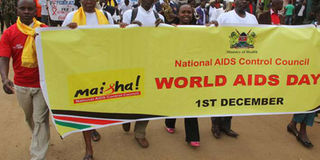Expert warns of failure to meet targets in war on Aids

Kenyans mark the 2014 World Aids Day. WHO reports say since 2000, new HIV infections globally have fallen by 35 per cent and Aids-related deaths by 24 per cent. PHORO | JARED NYATAYA | NATION MEDIA GROUP
What you need to know:
- UNAids says the theme is part of a vision of achieving “zero new HIV infections, zero discrimination and zero Aids-related deaths”.
- Currently, there are 1.6 million people living with HIV in the country, with only 596,228 on antiretroviral drugs (ARVs), according to data from the Kenya Aids Response Progress Report of 2014.
As the world marks the 27th World Aids Day on Tuesday, an expert says the country may not meet the internationally set standard of ‘Getting to zero’.
Under an ongoing international theme of ‘Getting to zero’, started in 2011, the world will be celebrating the milestones that have been achieved in reducing the number of new HIV infections as well as Aids-related deaths.
UNAids says the theme is part of a vision of achieving “zero new HIV infections, zero discrimination and zero Aids-related deaths”.
Although Kenya has made significant strides in reducing the number of HIV cases, the expert says unless more is done, the country may fail to meet this set target.
Mr Peter Oyaro, who heads the Family Aids Care and Education Services, said for the country to make an impact, it needs to more than double its efforts in the fight against the epidemic.
“Getting to zero requires concerted efforts across the board. We need more education as well as behaviour change,” said Mr Oyaro.
Currently, there are 1.6 million people living with HIV in the country, with only 596,228 on antiretroviral drugs (ARVs), according to data from the Kenya Aids Response Progress Report of 2014.
As Mr Oyaro explains, one of the measures the country needs to take is to implement the new guidelines set by the World Health Organization (WHO) that recommend that anyone who tests positive for HIV should be put on ARVs immediately.
BEHAVIOR CHANGE
He said there is also a need for behaviour change among the people.
According to him, many people are still not using protective measures and getting tested as expected.
“Condom use is still low among all categories of people. At the same time, testing is not as per our expectation,” he said.
There is also a high rate of stigma and discrimination, which is preventing some individuals from getting tested.
“If we are to win the fight against HIV, the population must begin to look at HIV differently. Without stigma, we can sort out this issue,” he said.
WHO reports say since 2000, new HIV infections globally have fallen by 35 per cent and Aids-related deaths by 24 per cent.
The number of people receiving ARVs has also increased to 16 million, with 1.9 million being newly put on antiretroviral treatment in 2014 — one of the largest annual increases ever.





